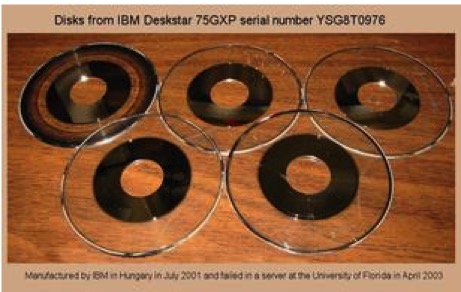History (2001): IBM 75GXP HDD Family
Experienced very high field failure rate
This is a Press Release edited by StorageNewsletter.com on July 3, 2018 at 2:21 pmThis article comes from WikiFoundry, Inc.
2001:IBM 75GXP Family
Product experienced high field failure rate

Why it’s important
All drives fail at varying rates, but it is unusual for the failure rate to reach the level of public discussion and litigation as happened in the case of the IBM 75GXP family.
Discussion:
First shipped March 2000. Perhaps 7.2 million units shipped
This was IBM’s first desktop drive to use a 3.5-inch disk with a glass substrate. In 1999 IBM began using such disks in their much lower volume Ultrastar product family. Glass disks were used reliably by IBM and many others in 2.5-inch HDDs beginning as early as 1990 (see Toshiba MK1122FC).
Problems appeared in public in 2001 A thread on this subject, Dr. Evil asks: GXP problems, beginning August 31, 2001, gets more than 1,300 subsequent posts, many describing product failures and becomes known as the thread that won’t die. According to IBM internal documents failure rates for some customers exceed 6.5%. One large customer experienced ten times the failure rate when compared to a similar Maxtor drive.
In 2001 Michael Granito, Jr., filed a class action lawsuit alleging that the 75GXP contains “a uniform defect in the design” that causes the product to crash resulting in “the irretrievable loss of data and programs stored on the disk.” Granito described one manifestation as following, “the sudden occurrence of a loud clicking or scratching noise, the Deskstar 75GXP stops operating and ‘crashes.’ The 2003 photo above shows one failure likely to have a manifestation such as Granito described. Class action was awarded in 2003 and settled in 2005.
IBM’s pleadings deny any underlying systematic problem but IBM documents show a very high failure rate and other documents suggest one or a combination of the following problems may have existed and led to the high failure rate (listed alphabetically):
• Contamination
• Delamination of the magnetic surface
• Firmware bugs
• NVRAM problems
• Windows 98 bug
While denying problems, IBM did produce a Rev 2 model with a recessed head, newer firmware, an improved manufacturing process to reduce contamination, and better quality assurance. One firmware change was to introduce ‘wear leveling’ such that the heads did not remain on a single track for extended periods of time.
The class was defined as all persons and entities in the United States who, during the period March 15, 2000 through March 4, 2005, purchased the following family of IBM Deskstar 75GXP HDD models: DTLA 307-015; DTLA 307-020; DTLA 307-030; DTLA 307-045; DTLA 307-060; DTLA 307-075.
Persons with actual failed drives received a check for $100.
Persons with drives that did not fail received either 25 blank CD-ROMs (with jewel cases) or a 15% discount certificate for a future purchase at IBM.com.
Lawyers got up to $9.95 million.
Cash awards distributed on 4/2/2008













 Subscribe to our free daily newsletter
Subscribe to our free daily newsletter

